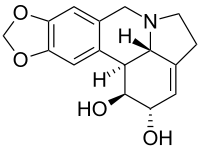Lycorine
 | |
| Names | |
|---|---|
| IUPAC name
1,2,4,5,12b,12c-Hexahydro-7H-[1,3]dioxolo[4,5-j]pyrrolo[3,2,1-de]phenanthridine-1,2-diol | |
| Other names
Galanthidine, Amarylline, Narcissine, Licorine, Belamarine | |
| Identifiers | |
| 476-28-8 | |
| ChEBI | CHEBI:6601 |
| ChEMBL | ChEMBL400092 |
| ChemSpider | 65312 |
| |
| Jmol-3D images | Image |
| PubChem | 72378 |
| |
| Properties | |
| Molecular formula |
C16H17NO4 |
| Molar mass | 287.31 g·mol−1 |
| Except where noted otherwise, data is given for materials in their standard state (at 25 °C (77 °F), 100 kPa) | |
| | |
| Infobox references | |
Lycorine is a toxic crystalline alkaloid found in various Amaryllidaceae species, such as the cultivated bush lily (Clivia miniata), surprise lilies (Lycoris), and daffodils (Narcissus). It may be highly poisonous, or even lethal, when ingested in certain quantities. Symptoms of lycorine toxicity are vomiting, diarrhea, and convulsions.[1] Regardless, it is sometimes used medicinally, a reason why some groups may harvest the very popular Clivia miniata.
It inhibits protein synthesis,[2] and may inhibit ascorbic acid biosynthesis, although studies on the latter are controversial and inconclusive. Presently, it serves some interest in the study of certain yeasts, the principal organism on which lycorine is tested.[3]
Daffodil bulbs are sometimes confused with onions, leading to accidental poisoning.[4]
References
- ↑ Lycorine, definition at mercksource.com
- ↑ Vrijsen R, Vanden Berghe DA, Vlietinck AJ, Boeyé A (1986). "Lycorine: a eukaryotic termination inhibitor?". J. Biol. Chem. 261 (2): 505–7. PMID 3001065.
- ↑ Garuccio I, Arrigoni O (1989). "[Various sensitivities of yeasts to lycorine]". Boll. Soc. Ital. Biol. Sper. (in Italian) 65 (6): 501–8. PMID 2611011.
- ↑ Pupils ill after bulb put in soup, BBC News, 3 May 2009
External links
- Hill, R. K.; Joule, J. A.; Loeffler, L. J. (1962). "Stereoselective Syntheses of d,l-α- and β-Lycoranes". Journal of the American Chemical Society 84 (24): 4951–4956. doi:10.1021/ja00883a064.
- Wolfgang Oppolzer, Alan C. Spivey, and Christian G. Bochet (1994). "Suprafaciality of Thermal N-4-Alkenylhydroxylamine Cyclizations: Syntheses of (±)-α-Lycorane and (+)-Tianthine" (PDF). J. Am. Chem. Soc. 116 (7): 3139–3140. doi:10.1021/ja00086a060.